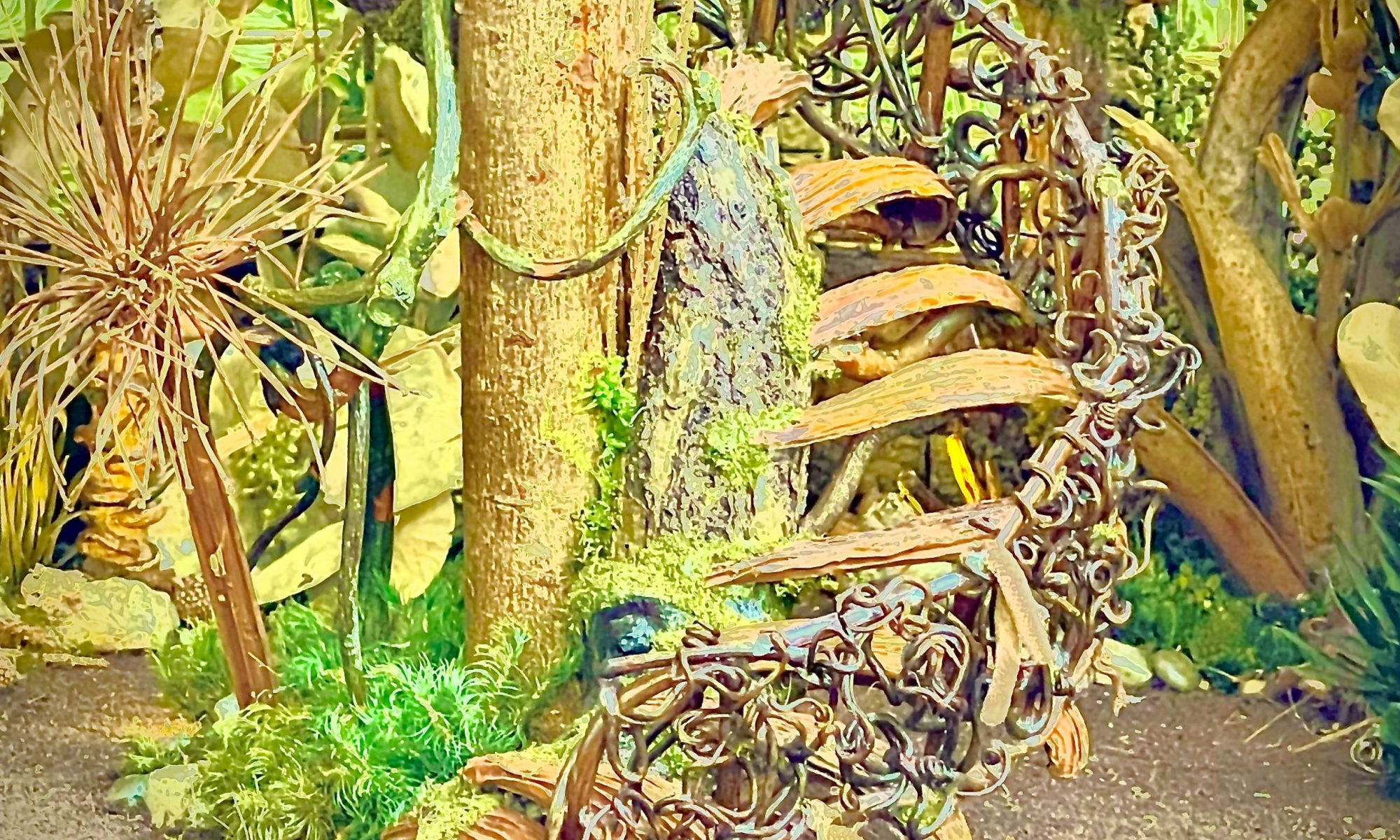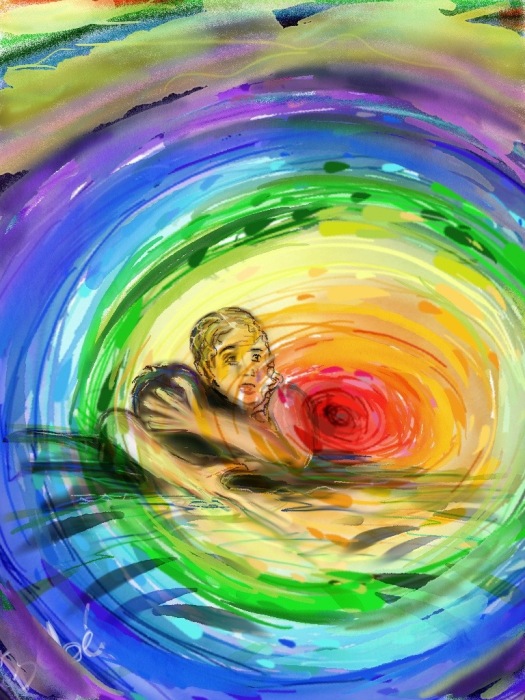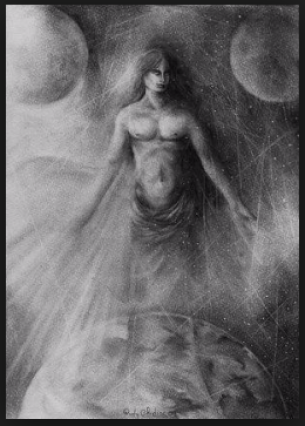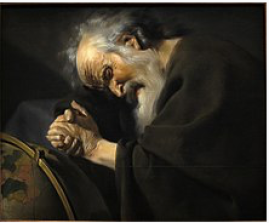The featured image of this post came to me in a dream two years ago, and just several days after the company I worked for laid me off 12 days before Christmas. I had worked hard for this company for six years, yet despite knowing who they would lay off more than a month in advance, they did not provide advance warning to allow me or the others to prepare. Quite the opposite, I remember the Human Resources guy calling me early in November to tell me I had 28 days of vacation. He told me he so rarely gets to share good news like this, so this was why he was calling me—to share this wonderful news! Little did I know this jolly news was soon to become my life raft for the company was in trouble. It had lost a huge government contract and was having a hard time reckoning with the reality of needing to sacrifice some of its employees for the good of the rest chosen to remain onboard the corporate ship (or perhaps it should be the corporate submarine). Of the small group of employees who were selected to be deep sixth (i.e., a nautical expression that acquired its idiomatic definition because something thrown overboard at or greater than this depth would be difficult, if not impossible, to recover), I was the only writer. Also, I was the writer who had been there for the longest consecutive years and one of the highest compensated writers at that time. Adding insult to injury, the year before my husband endured a similar sacrifice, though the motive in his case was to raid the pot of money sustaining his small department.
It took 7 months to find new job after my corporate Christmas gift, and the job I found paid far less and demonstrated extreme bouts of incompetence. Then, came a moment (a year later) when incompetence met competence toe to toe. In this short amount of time, I had written grants that brought in more than $500,000 dollars, but this little company was not honoring our compensation agreement, so I was calling them to task on this issue. After my father suffered a massive heart attacked and died 9 days later, the little company took that moment to fire me. None of this matters except in our human world people need jobs to live in houses, to buy food, to support their children, and to do whatever other things they must do to care for self and family.
As a younger worker, these cruel culling practices go mostly unnoticed. But, it happens, and it happens for many reasons—greedy corporate executives gamble and lose the companies money and everyone loses their job; higher paid older workers are pushed out years before they are ready to retire; a weak boss fires an employee perceived as a threat; jealous peers gain up to get an employee fired or laid off simply because they are demonstrating more competence than they are; and the list of reasons why workers are culled from the workforce goes on…often good employees are culled at the peak of their adult financial responsibilities (e.g., aging parents, children in college). It is humiliating to end up here, thus many workers who end up in this situation don’t talk about what happened to them and their families. However, once you join this club of culled workers, you begin to understand this is happening everywhere and at every level (blue collar workers to Ph.Ds.). Pretty much anywhere Western economic systems have been embraced, these cruel culling practices are employed. It is probably happening right now to someone you know, and it is not normal.
Just 100 years ago, at the beginning of the RISE of the mega corporation, it was different. In an interview about his new book Zucked, Roger McNamee expresses that back then employees were more highly valued than they are today. He said corporations invested in their workers, the communities where their employees lived, along with watching out for the interests of their stakeholders. Certainly, corporations were not angels back then with many guilty of significant human infringements (e.g., employing children, paying extremely low wages, making workers work excessively long hours and work weeks). However, it seems there was more resilience and balance in our system 100 years ago that allowed workers to RISE and demand better pay, more humane working conditions, and living wages within humane working hours. Many corporations learned (or listened) and amended their ways and/or new laws were enacted (e.g., 40-hour work week, child labor laws passed), resulting in a little bit of a balance between worker and employer to be restored.
Go back another 100 years to the beginning of the Industrial Revolution when most people still worked on farms or in cottage industries—the baker, the shoemaker, and the dress maker. Every town had a baker, a shoemaker, and a dress maker, and cities could support many individuals working in the same area to provide for the needs of the community. These individuals had self-agency, not that this made their lives easier or protect them from cultural biases or discrimination, but they were independent, not owned by a mega corporation or franchise.
Go back even further and sure life gets even harder, but individuals who could creatively problem solve were highly valued. Small tribes in these ancient times were faced with many challenges that threaten their survival and creativity meant the tribe had a better chance at surviving, especially during tough times. When we talk about tribalism today, we often only think of the savage side of tribal communities, failing to see the nurturing and protective side these small group of people enjoyed and thrived within.
It was during my second experience of being culled from the workforce that I came across an unusual musical group called Heilung. I could not understand what they were saying, but it was the only music that made sense to me during this time, so I listened to every song I could find over and over. Several of their songs made their way into The Divine Dodo series appearing as musical guides to help the poor Dodo escape the vacuous void he had become trapped inside. In a post to my small bubble of Facebook friends, I said: “It is not a modern musical group—let me just say this upfront—it is ancient and for most people it will not appeal to you in the least. But what they are doing is so important to modern man for Western ways have become fractured (i.e., mostly the male consciousness), and this is making the world very sick today. This group’s chants go to a very deep place in the human consciousness that reaches states people today might say is awake.” I did research on them and found some of their chants come from the Merseburg Incantations, which are some of the oldest known pieces of Old German literature dating back to the 9th or 10th century (maybe even 2nd to 5th century—this is still being debated).
Heilung describes its work as amplified history from early medieval northern Europe and not to be mistaken for a modern political or religious statement of any kind. They post with many of their songs: “Remember that we all are brothers… All people, beasts, tree and stone and wind… We all descend from the one great being… That was always there Before people lived and named it… Before the first seed sprouted.”
The song I wish to highlight for this post is Krigsgaldr. If you click on the embedded link, you will go to a video Heilung made to dramatize this song. They sing it completely in the ancient dialectic, so you will not understand it, but the emotions are clearly transmitted through their voices. What strikes me is the dynamic balance between the woman’s voice in contrast with the guttural, harsh Rune Reader’s voice as well as the warriors. It is absolutely beautiful. This masterful reimagining of our ancestors demonstrates they probably understood the power and ways of the human psyche and soul better than we do today.
In this version of the same song, the Rune Reader sings his part in English: Krigsgaldr with English portion sung by Rune Reader. It is clear the tribe has been brutally attacked—their women and children killed. The Rune Reader says that they wish to live in peace, but the attackers only understand the language of war. Therefore, the tribe is invoking a ritual to plunge themselves into an unconscious state to protect what they love. Heilung can only reimagine how they might have done this, but what they have reimagined and perform for us is incredible, powerful, and terrifying for you realize how monstrous we can become when we descend into this place that is inside us all—a place that is capable of annihilation. I remember a documentary I saw some time ago that told how Hitler was fascinated by the ways of Germany’s tribal ancestors and wanted to bring them back. But he only wanted one side of them, and this is inherently lopsided like the Black Magician and White Magician from my post Is Collective Transformation Possible? Our ancestors’ held deep wisdom about the ways of the unconsciousness and the depths to which the human soul can fall. Thus, our ancestors performed elaborate rites and rituals to guide themselves through such journeys, especially the downward ones.
This is a similar understanding and ritual to what I write about in the post What Do I Do with the Mad Inside Me? In this post, I write about the elaborate war ritual that conflicting clans within the Fayu tribe engaged before the first arrows were released—a ritual that probably evolved over centuries. It was their way of channeling the Mad Inside them. It is very important to note that I am in no way glamorizing the ways of ancient tribes or saying our modern world needs to return to this state of being. In fact, several chapters later in the book child of the jungle, the author talks about the cycle of death that spun out of control between the warring clans of the Fayu tribe. In chapter 14, she describes how the Fayu did not understand the mechanism of disease or natural death, and therefore they attributed symptoms of disease and death to spiritual or magical causes. She says, “If a member of my family or clan died of disease, it would be my duty to determine who cursed that person. Then, I would be forced to avenge my relative. For example, an Iyarike would have an argument with a Tigre. A short while later, the Iyarike might die a natural death (e.g., from malaria). The immediate assumption would be that the Tigre must have cursed the person who died in retaliation for the argument they had. The Iyarike would then be obligated to kill the first available (i.e., most vulnerable) Tigre.” The Iyarike and Tigre were two clans of the four clans making up the Fayu tribe. The author recounts how this cycle of murder and revenge spun further and further out of control, resulting in the Fayu’s population dwindling from thousands down to several hundred. She says, “their culture had developed a singular focus on revenge without mercy or tender affection.”
We are all susceptible to psychic imbalances—ancient or modern. And, clearly having too little understanding for our outside reality (e.g., not understanding disease or natural death) hinders our development as a human being (and a species), but so too does having too little understanding of our inner reality; this also hinders our development. I do not wish to digress too far down this path for the focus of this post is our current economic reality. However, I would like to draw your attention to another of my older posts entitled The Collective Unconscious and the Oversoul. In this post, I quote Carl Jung who says: “The unconscious no sooner touches us than we are it–-we become unconscious of ourselves. That is the age-old danger, instinctively known and feared by primitive man, who himself stands so very close to this pleroma. His consciousness is still uncertain, wobbling on its feet. It is still childish, having just emerged from the primal waters. A wave of the unconscious may easily roll over it, and then he forgets who he was and does thing that are strange to him. Hence primitives are afraid of uncontrolled emotions, because consciousness breaks down under them and gives way to possession. All man’s strivings have therefore been directed towards the consolidation of consciousness. This was the purpose of rite and dogma; they were dams and walls to keep back the dangers of the unconscious, the ‘perils of the soul.’ Primitive rites consist accordingly in the exorcizing of spirits, the lifting of spells, the averting of the evil omen, propitiation, purification, and the production by sympathetic magic of helpful occurrences.”
In Heilung’s song, the tribe is choosing to descend, but they are attempting to guide (and perhaps control a little bit) their collective descent through an elaborate ritual that is balanced by deep love (i.e., the woman’s voice, their priestess). Today, we have forgotten this, and we do so at our own peril. Around the world, we see the effects of this forgetting for there are many warning signs. But getting back to the role of corporations, I would like to circle back to Roger McNamee and his book Zucked. In the interview I heard, he told Joshua Johnstone (the host of 1A) that what we have today is not capitalism as it existed 100 years ago, but rather a mutated and more predatory form of it. He expressed in this interview how corporations used to hold themselves accountable to their employees, their community, and their stakeholders (as I have mentioned), but now, they value only the stakeholder… the bottom line… profit. Comparing what he says with my personal experiences, it is my belief that when the stakeholders and profit becomes the highest value a corporation measures all its decisions against, they become capable of sacrificing the well-being of the human beings who work for them (or the human beings they say they are here to serve), often in the cruelest ways. Worst of all, this behavior is tolerated by many companies and indeed by us all. Perhaps this tolerance fits within our ideas about survival of the fittest for surely we want the strongest and fittest corporations to survive to protect us, but we have ended up with predators! Thus, this belief is as lopsided, and anything lopsided is going to spin out of control sooner or later.
McNamee is writing about Facebook because he mentored Mark Zuckerberg in its early days, and he is a stakeholder. When he began to see the lopsided nature of their business model and vision, he sounded the alarm. But by then, Facebook was too far in and committed to their model and vision. McNamee says this vision is shared by many modern companies and corporations not just Facebook (so this is a much bigger problem on our hands). In another interview he gave with The Guardian, McNamee talks about two important aspects of the NEW modern business model that has emerged. These are the questions he was asked, followed by his answers:
- When did you first realize that things had taken a turn for the worse: McNamee answers: “I met Tristan Harris, a design ethicist from Google, who talked about what he called “brain hacking”, a term that he invented to describe the persuasive technologies used by internet platforms that enable them to develop habits in the minds of the people who use the products. Those habits evolve into addictions, and that situation makes [users] vulnerable to manipulation. Like a stroke of lightning, it made me see what it was that had potentially influenced the election in the U.S. and had potentially influenced Brexit.”
- You said Brexit was a wake-up call. Why was that? Wake-up Call: McNamee answers: “It never occurred to me that there would be an asymmetry in the way that advertising works. That in order to command attention, you want to appeal to what [Tristan Harris] calls “the lizard brain”, the things that provoke outrage and fear. Things that essentially create a perception of reward. Those things, when you put them into advertising, can really be bad for democracy. Suddenly a neutral centrist idea gets very little traction on Facebook, where really extreme, emotionally charged ideas are viral. There’s evidence that in the US, the messages of the Trump campaign got 17 times the effective reach per dollar spent as Clinton’s messages, and that’s just a staggering advantage.”
I will not belabor these interviews for I think it is best for anyone who is interested in this subject to listen and read them for yourself and come to your own conclusions. I can only make my own conclusions based on my experience.
I will venture to say I believe we have been lulled into an unconscious sleep by the economic systems we have created to keep us safe. These systems have spawned giant corporations who have become increasingly lopsided in their vision, and they are gobbling up power, perhaps even unconscious of their unquenchable appetite. But, they crave it deeply—this power—and they will not let it go easily…not without deep conscious work. The corporations of today tell us that their behavior is completely normal (i.e., culling older workers, mass layoffs, putting stakeholders of big companies at the center of all business decisions). They tell us it has always been this way, but this is a lie. This type of behavior cuts us off from our shared humanity. It dehumanizes us by pitting us against each other and locking us into intense competition for who gets to stay on board the corporate ship (or rather the corporate submarine).
In this lopsided primal state, we are capable of tremendous cruelty for the sake of survival. But it is really corporate survival, isn’t it, and corporate survival is very different from human survival. Now, our collective human consciousness seems to be sinking faster and going deeper than ever before. One striking consequence of this rapid sinking of our collective consciousness is climate change that looks like it is accelerating faster and becoming much more destructive than we previously thought possible.
Thus, I have come to realize all of this is contained within the image I drew more than 2 years ago…that of reptilian instincts. Given my recent trauma, I animated this image to show an awakening—the eyes of which are distinctly human and clearly feminine—perhaps this is our lost or forgotten balance?

I will add one final insight about this image that comes from a BBC report I heard on October 25, 2018. In this report, they said a mother’s voice works better than a fire alarm to wake children up. Thus, by adding a human voice to smoke detectors, we could save lives— children’s lives.
What if we are these slumbering children who have been lulled into a prolong and extended state of unconsciousness by the system(s) we believe to be designed to sustain us. Rather they are putting us to sleep and keeping us asleep. We need to wake up and make the hard choices required to mitigate the direst effects of climate change for these choices require scarifies. But really, the biggest sacrifices need to be made by corporations, and they really don’t want to change—I’ve heard Trump say these very words often (just replace they with I). Without dramatic changes Now, the climate effects we are witnessing Now (e.g., 1,000-year floods occurring one after the other, huge and deadly wildfires, prolonged droughts, polar ice caps melting, species and habitat destruction) will only get worst in this century. It is happening Now, to someone you know.
We need to hear our mother’s voice. She is trying to wake us up. She has been trying for many years, but we are deep sleepers.
— Abiogenesis, Carbon Based Lifeforms















